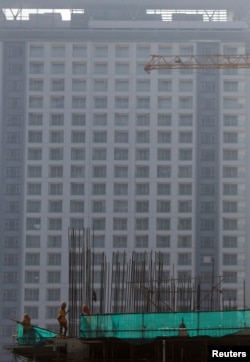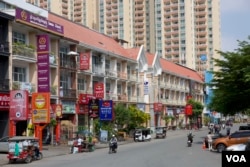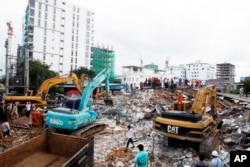PHNOM PENH, Cambodia – A quick glance at Phnom Penh’s skyline reveals a now-familiar sight – yellow construction cranes peppered across the growing metropolis. During the day, the cranes sway around, groaning under the weight of construction material. At night, the sky is dotted with little red specks – the cranes’ safety lights glowing in the dark.
Horm Piseth gets to view these cranes from his condominium on Chroy Changvar peninsula, on the eastern bank of the Tonle Sap. The 33-year-old businessman last year purchased the condo in a modern housing development. The $80,000 investment got him a one-bedroom apartment, with the added benefits of a gymnasium and swimming pool.
But it served two objectives: to live independent of his parents and close to his workplace. The former was a hard sell for his family.
“The concept of [a condo] among old people is zero,’’ he said recently sitting in his office. “They don't want us to buy a condo.’’
Horm Piseth’s family instead suggested a compromise: invest $40,000 to $50,000 in a condo but only as an investment, not as a primary residence. However, Horm Piseth chose to spend nearly double their recommendation to buy the condominium.
The young businessman is part of a small minority of Cambodian buyers in the fledgling, affordable condominium market in Phnom Penh. Analysts say local buyers are priced out of most real estate projects, which are on the expensive end of the price spectrum, while at the same time there is a lack of appetite for the condo lifestyle.
The construction sector has seen a massive boom starting in 2015, climbing to become a leading pillar of the Cambodian economy, along with the garment, agriculture and tourism industries. A large chunk of this investment has come from China and is directed towards infrastructure, commercial and residential real estate projects, linking the sector closely to the outlook of the Chinese economy.
Real estate firm CBRE reports that nearly 17,000 condominiums will be added to Phnom Penh’s burgeoning housing stock just this year. Another firm, Knight Frank, estimates there will be around 47,000 unsold condos by the end of 2022. Most of this construction is centered around Phnom Penh and Sihanoukville, the latter seeing a more recent influx of Chinese investment. The tourist haven of Siem Reap and up-and-coming Battambang have seen smaller infusions of construction investment.
With the number of unsold condominium units increasing, there are concerns over the viability in Cambodia of this urban model of living, especially in the mid-range and high-end segments. Even for an early adopter like Horm Piseth, the apartment is viable for maybe a few years, he said. After he gets married, and when he becomes a father, he will want a house.
“Two people living in a condo for 3 to 5 years is fine, but when we decide to have kids we need to expand our family,” Horm Piseth said. “Kids cannot stay in a condo. We will need a bigger space.”
Limited market
Cambodian homeowners have largely lived in independent houses – mostly wooden and stilted in rural areas or on the outskirts of the capital – and shop houses in urban areas. Apartments form a small slice of living options, with condominiums a more recent possibility.
The lack of Cambodian interest in the condo market stems in part from the affordability of such housing. A Knight Frank report from May shows that a studio apartment in the plush Tonle Bassac neighborhood of Phnom Penh would cost around $60,000, whereas a one-bedroom condo could cost up to $100,000.
Sambo Visal, who invested in a condo and is looking to sell it, said house sales are much easier, given the higher volume of transactions. He points out that while it is expensive to buy a condo, there are additional costs after buying the unit, such as building maintenance charges, that could put off potential buyers.
“I think that house sales are still more profitable because the condo market is still limited,” Sambo Visal said. “Not many [local] people want to buy condos, and most of the buyers are foreigners.”
With local buyers not the primary target, these housing blocks have adopted a more Western or Chinese aesthetic. Unlike the nuclear lifestyle afforded by a condo, most Cambodians seem to prefer a more communal setting with a front yard or open space to socialize.
“The design of Chinese-designed and built condominiums is typically tailored specifically for Chinese tastes, and may not be particularly well suited to investors or occupants from other nations,’’ said James Hodge, an associate director at CBRE. “This places more pressure on the continuation of Chinese investment into the condominium sector.”
For now, Chinese investment is the primary driver of the sector. Ministry of Land Management statistics show China foreign direct investment accounts for at least half of all incoming investment, outranking the total foreign direct investment from 21 other nationalities. Most of this is directed towards construction activity. Last year, China infused more than $2 billion in approved investments.
These developments have interlaced the Cambodian economy with the prospects of the Chinese economy. This year, the World Bank in an annual report said that a “slowdown or reversal of FDI inflows, especially Chinese FDI, will significantly impact private investment and growth” in Cambodia.
“We can see the pace of the supply of condos,” said Nget Chou, senior consultant at Emerging Markets Consulting.
“This won't be to fit the needs of the locals but instead that of the Chinese. If there is a decrease in the number of Chinese, it could cause problems for the property sector.”
The steady flow of cash from China has also raised some concerns over money laundering activities. Land and real estate buys are preferred destinations for laundered money in many countries. In early June, Minister of Interior Sar Kheng expressed concerns over the rise of money laundering activities in Cambodia and ordered tough measures on the issue.
Nget Chou, the consultant, said it was hard to definitely pinpoint if condo sales were part of a money laundering, but a high frequency of cash payments for expensive condos should raise a few red flags.
“It can be true, and it can be false,’’ Nget Chou said. “But in reality, we can see that there's a lot of cash money use.’’
However, government official Seang Lot is unconcerned about the sector’s reliance on Chinese investments. The spokesman for the Ministry of Land Management said the influx of money had only benefitted Cambodians, and that the government was hoping to attract additional foreign investment.
“So, what we want is a lot of investment,’’ Seang Lot told VOA Khmer. “Thus, in the future, we need to push for more investment and we also welcome investment from the China.”
Safety concern
Sihanoukville, in the southern province of Preah Sihanouk, has been at the center of the recent property boom, but a tragedy in June has raised a new concern in the minds of condo buyers – the safety of these buildings, which normally house many condominium units.
In June, an under construction seven-floor building collapsed in the coastal town, killing at least 28 workers and injuring more than two dozen others. Minister Sar Kheng said that the building did not have the requisite permits, later saying other construction projects were lacking official approvals. A July letter extended this concern to Phnom Penh as well.
Nget Chou acknowledged the general dearth of planning and organization in the construction sector could be detrimental to its future, as evidenced by the lack of a law governing construction activities. A longtime observer of Cambodian affairs said it was important for the Cambodian government to wisely use available resources and, rather than more condominiums, authorities should build affordable houses meant for Cambodians.
“It should stop this phenomenon,’’ said Ear Sophal, who is an associate professor of diplomacy and world affairs at Occidental College in Los Angeles. “It is a waste of resources and is driving-up real estate prices while not providing more capacity for the kind of housing Cambodians need.”
If the sector continued its current trajectory, Ear Sophal said, it was likely the big condominium projects would turn into “ghost condos,” like the projects on Phnom Penh’s Koh Pich island, with no residents and only investors who did not care about rental incomes.
“Most of these condos are left empty. They are not even interested in renting [them] out. Only in keeping it as an investment,” he said.







